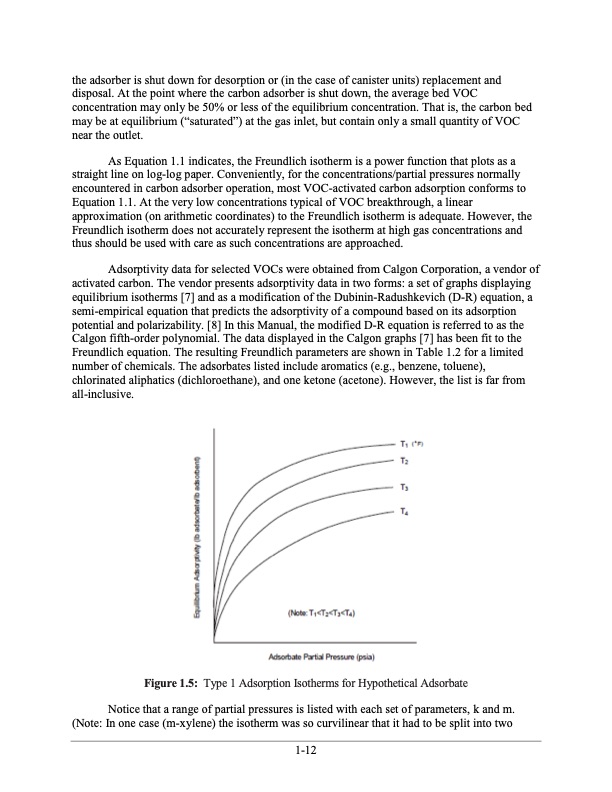
PDF Publication Title:
Text from PDF Page: 016
the adsorber is shut down for desorption or (in the case of canister units) replacement and disposal. At the point where the carbon adsorber is shut down, the average bed VOC concentration may only be 50% or less of the equilibrium concentration. That is, the carbon bed may be at equilibrium (“saturated”) at the gas inlet, but contain only a small quantity of VOC near the outlet. As Equation 1.1 indicates, the Freundlich isotherm is a power function that plots as a straight line on log-log paper. Conveniently, for the concentrations/partial pressures normally encountered in carbon adsorber operation, most VOC-activated carbon adsorption conforms to Equation 1.1. At the very low concentrations typical of VOC breakthrough, a linear approximation (on arithmetic coordinates) to the Freundlich isotherm is adequate. However, the Freundlich isotherm does not accurately represent the isotherm at high gas concentrations and thus should be used with care as such concentrations are approached. Adsorptivity data for selected VOCs were obtained from Calgon Corporation, a vendor of activated carbon. The vendor presents adsorptivity data in two forms: a set of graphs displaying equilibrium isotherms [7] and as a modification of the Dubinin-Radushkevich (D-R) equation, a semi-empirical equation that predicts the adsorptivity of a compound based on its adsorption potential and polarizability. [8] In this Manual, the modified D-R equation is referred to as the Calgon fifth-order polynomial. The data displayed in the Calgon graphs [7] has been fit to the Freundlich equation. The resulting Freundlich parameters are shown in Table 1.2 for a limited number of chemicals. The adsorbates listed include aromatics (e.g., benzene, toluene), chlorinated aliphatics (dichloroethane), and one ketone (acetone). However, the list is far from all-inclusive. Figure 1.5: Type 1 Adsorption Isotherms for Hypothetical Adsorbate Notice that a range of partial pressures is listed with each set of parameters, k and m. (Note: In one case (m-xylene) the isotherm was so curvilinear that it had to be split into two 1-12PDF Image | Carbon Adsorbers

PDF Search Title:
Carbon AdsorbersOriginal File Name Searched:
final_carbonadsorberschapter_7thedition.pdfDIY PDF Search: Google It | Yahoo | Bing
CO2 Organic Rankine Cycle Experimenter Platform The supercritical CO2 phase change system is both a heat pump and organic rankine cycle which can be used for those purposes and as a supercritical extractor for advanced subcritical and supercritical extraction technology. Uses include producing nanoparticles, precious metal CO2 extraction, lithium battery recycling, and other applications... More Info
Heat Pumps CO2 ORC Heat Pump System Platform More Info
| CONTACT TEL: 608-238-6001 Email: greg@infinityturbine.com | RSS | AMP |